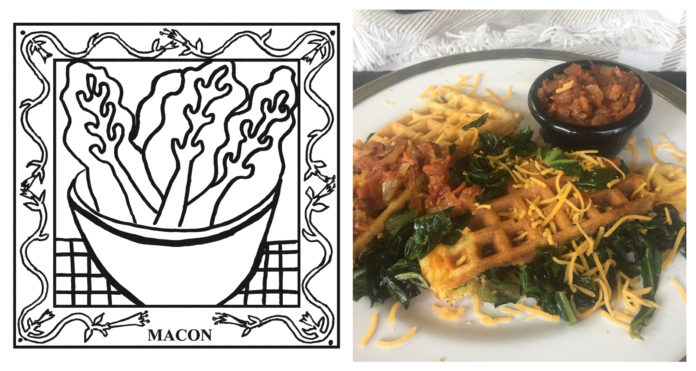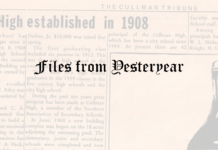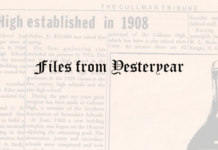
The Cullman Tribune is celebrating the Alabama Bicentennial (1819-2019) with statewide field reporting by Alabama Master Gardener/Botanical Artist Ben Johnson South. This year-long feature, “The 67-County Alabama Garden Party,” will spotlight different counties each week. Each county will get its own “quilt block,” along with a historical profile, and we’ll share a recipe specific to the area. At the end of the year, all 67 counties will be put in a book to commemorate the Bicentennial.
Macon County
On our progressive garden party through Alabama we’ve found magnificent fruits and vegetables in every farmers’ market. Macon County has a mild climate, rich soil, plenty of sunshine and enviable rainfall. You can grow just about anything under the sky in this part of the world.
Macon County was established by European Americans in December 1832 from land ceded by the Creeks after the Indian Removal Act of 1830. The native inhabitants, who had been in this part of Alabama for thousands of years, were exiled to territory west of the Mississippi River. Then, white settlers brought enslaved Africans to create expansive cotton plantations.
To feed the plantation families, day workers, indentured and enslaved workers, there were large, shared gardens and orchards. Let me recommend these delicious finds grown in Macon County: collard greens, okra, watermelons, and black-eyed peas. None of these plants is native to Alabama or even North America but all are savored throughout the 50 states. So, where were these plants before they were transplanted to this continent? Africa, all of them.
Let’s take a closer look at just one of these treasured, immigrant plants. Collards are loose-leafed cultivars of Brassica oleracea and in the same species as kale, cabbage and broccoli. The name “collard” comes from the word “colewort” (the wild cabbage plant). These prized plants are grown for their large, sometimes 2-feet-high, dark-colored, nutrient-rich, edible leaves.
Collard greens came to America in the early 1600s with African slaves to Jamestown, Virginia.
Popular food blogger Michael Twitty, who is African-American, has said, “When you’re talking about collard greens, that is one of the few literal, visceral connections to the generations who came before us. By knowing the food, we know our ancestors.”
Twitty, who spent his college years at Howard University and later educated crowds in Colonial Williamsburg about slavery, explained, “I’m a Southern food writer who wants to embrace where I’ve come from, and that means talking about slavery and the dishes we (Americans) share that came from that interdependence.”
Collard greens can be grown year-round in Macon County, but are tastier and more valued as a source of nutrition in the cold months after the first frost. Collards are ornamental and are ideal for both raised-bed gardening and in containers.
Popular cultivars of collard greens include: Top Bunch, Blue Max, Vates, Georgia Southern, Morris Heading and Butter Collards.
Macon County cooks find various ways to serve collards, a staple vegetable in the cuisine of the American South. Collards are often served as “mixed greens” with similar, green-leafed vegetables such as spinach, kale, turnip greens and mustard greens.
Smoked meats are a popular combination with Macon County collards; smoked turkey drumsticks, smoked turkey neck and smoked pork neckbones are often added to diced onions, vinegar and peppers. Traditionally, collard greens and black-eyed peas or field peas are served on New Year’s Day to bring prosperity in the coming year- collards for folding cash and peas for the promise of more pennies.
Macon County is in The Black Belt region of Alabama, named for the rich soil of the area which made cotton planters wealthy in the 19th century. Today, the county is 83% African American and best known as the home of Tuskegee University, a private, historically Black university with more than 40 academic programs.
While we pause here in Macon County to express our gratitude for the early African Americans who brought collard planting to Alabama, let’s also reflect on the importance of the many other plants which were transplanted to our country from Africa, among them:
OKRA (Abelmoschus esculentus) “The Pods of the Gods, which grows naturally in Africa as a flowering plant of the mallow family which includes hibiscus flowers and cotton plants
BLACK-EYED PEAS (Vigna unguiculate) which are loaded with nutrients and yield impressive protein
WATERMELONS (Citrullus lanatus) which are enjoyed in every country of the world but the origins of the fruit are in Africa where watermelons grow naturally without agriculture
COFFEE (Coffee arabica) Ethiopian coffee is the earliest known origin of this popular drink which came to America via European settlers; coffee is only grown commercially in two U.S. states, Hawaii and California.
There are many other positive and pleasurable ways PLANTS + PEOPLE have intersected over the last two-hundred years in Macon County, here are some:
*MACON COUNTY FARMERS’ MARKET- Intersection of Elm and Spring Streets, Tuskegee, AL 36083; Wednesdays and Saturdays 8-2 p.m., May-September and October-March 9 a.m.-noon
*MACON COUNTY FARMSTANDS- Alphonso Hooks (Shorter), Richard Hajek (Shorter)
*MACON COUNTY BLUEBERRIES- Al Hooks Produce (Shorter), Shady Grove Blueberry Patch (Tuskegee)
*TUSKEGEE UNIVERSITY- Established in 1881 by Booker T. Washington, it was home to plant scientist, Dr. George Washington Carver and to World War II heroes, the Tuskegee Airmen. The large and beautiful campus was designed by David Williston, the first professionally trained, African-American landscape architects.
*THE GEORGE WASHINGTON CARVER MUSEUM- For more than 40 years, Dr. Carver, a son of a slave woman, labored at Tuskegee Institute where he researched plant life and educated farmers about the importance of “crop rotation” and other agricultural innovations. He is particularly remembered for his enthusiastic promotion of peanut and sweet potato farming. The museum, which opened in 1941 on the campus of Tuskegee University, was the former laundry and was funded largely by industrialist Henry Ford, an admirer of Dr. Carver’s work. The museum has a permanent collection which includes many plant drawings and artifacts that belonged to Dr. Carver, who died in 1943 and is buried in the campus cemetery.
*THE OAKS- Former home of Booker T. Washington, the visionary and progressive founder of Tuskegee Institute is now the President’s Home of Tuskegee University.
*THE LITTLE TEXAS TABERNACLE- It’s an outdoor, religious worship structure built of local timber by white and black people in the Little Texas, Alabama community and has been the site of camp meetings since 1850.
*TUSKEGEE NATIONAL FOREST- At 11,252 acres, this is the smallest national forest in the U.S. There are four main hiking trails of particular interest is Bartram’s Trail, which recognizes the route America’s first native born artist/naturalist William Bartram, the appointed botanist of Britain’s King George III traversed in 1775-1776 recording scientific notations and drawings of local flora and fauna.
*LAKE TUSKEGEE- A city-owned, landscaped recreational area with magnificent trees and planted areas with 92 acres of water provide swimming, fishing and sailing opportunities; the public grounds offer nature trails and picnic areas.
*PLANTING AN IDEA- Tuskegee University would be a natural place to celebrate the many contributions of African Americans to agriculture and plant life in the United States. This could be a research facility as well as curated collection. Many elements of this focus already exist at the university, but additional funding and prioritizing could expand awareness and impact.
Y’ALL COME to Macon County on your 67-County Alabama Garden Party Tour, where you can enjoy an array of American plants with roots that reach to Africa.
Thank you to Laurie Johnson who created the recipe for Collard Green Stuffed Cornbread Waffles with Bacon and Tomato Jam which adds another creative use of this green-leafed goodness to the Alabama recipe box.
Macon County Collard Green-Stuffed Cornbread Waffles with Bacon and Tomato Jam
Southerners either LOVE or HATE cooked greens and the LOVERS usually have a preference, with collard, mustard and turnip greens being the most popular. The traditional greens cooking method is a slow, stovetop steep where the greens cook down to about a quarter of their original bulk, typically served with pork, hot sauce, southern cornbread and other Southern vegetables. In this recipe, that combo is transformed into a collard green-stuffed cornbread waffle, served with bacon and tomato jam. This innovative version of a Southern favorite is a treat for either brunch or dinner.
Ingredients in rough order of use:
- 1/2 lb. thick cut bacon (recommend an Alabama favorite like Conecuh)
- 3 medium-ripe Alabama tomatoes, chopped
- 1 sweet onion and 1/2 fresh jalapeno without seeds, both finely diced
- 2 tbsp. finely minced fresh rosemary
- Salt and black pepper
- Balsamic vinegar
- Local honey
- 5 cups packed collard greens with ribs removed and chopped
- Waffle batter – Mix up your favorite waffle batter and substitute 1/4 of the flour with cornmeal (or use a prepared cornbread mix like Krusteaz – but this is not an ad!).
- Hot sauce and paprika
- About 1 cup finely shredded cheddar cheese
Instructions:
- Cook bacon in a deep skillet until crispy, drain and reserve. Pull out half of the bacon grease for the jam and leave the rest in the pan for wilting the greens later (turn off the heat).
- The Jam: In a medium saucepan, heat the removed bacon grease, 3 tbsp. each balsamic vinegar and water, diced onions and jalapeno, chopped tomato and minced rosemary with 1 tsp. each salt and black pepper. (Give the onions about a 5-minute head start since they need a little more cooking time.) Cook on low, stirring often, until the vegetables break down and the mixture is like a thick jam (about 25 minutes total). Add water if needed but cook most of it back out. At the end, add about 3 tbsp. honey and cook for another few minutes. Chop and stir in half of the bacon pieces. Set jam aside or refrigerate for up to a few days.
- The Greens: Warm the rest of the bacon drippings and stir in the greens for 10-15 minutes to wilt and cook al dente. Add salt, black pepper, hot sauce to taste and some olive oil if needed.
- The Waffles: Prepare waffle batter and add a few dashes of hot sauce and paprika to taste. Using a waffle iron that makes a thick waffle, heat to medium. Have the greens and cheese handy. Pour in a little less than half of the batter that you normally would and (working quickly) place a handful of the wilted greens and about 2 tbsp. shredded cheese into the center and cover with more batter, being careful to not overfill. Close the iron and cook to a golden brown.
- Enjoy these unique collard stuffed, cornbread waffles with the bacon and tomato jam plus more local honey or hot sauce as desired.
Also, check out Alabama Bicentennial: 200 ways to save Alabama for the next 200 years.
Copyright 2019 Humble Roots, LLC. All Rights Reserved.























